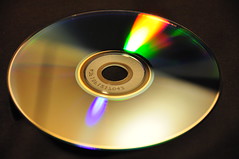The big re-rip
August 26, 2011 in digital music by Dan Gravell

Most people's first experiments with computer audio can be a rather floundering one, at least from the perspective of experience. I remember my own: run Windows Media Player, pop the CD in, out comes MP3s as if by magic. I saw album and artist names and was able to play the music from my hard drive, but I was isolated from knowing what the ripper actually did.
This is a general truism of using a music player to rip CDs, as most first-timers do. Music players like iTunes or Windows Media Player tend to offer fewer options than the dedicated CD rippers like EAC or dBpoweramp. There's no problem with this; indeed it's probably desirable for the first time user because otherwise the wall of options a dedicated CD ripper offers may be overwhelming. However, a music player that rips CDs tends to be constrained by its own limits as a music player.
After a while, you begin to learn more about computer audio. Particularly if you ever change or use different music players you begin to learn about concepts like tagging and the different ways album art can be stored. These techniques are essential for building a flexible, portable music library that can look and sound beautiful whether in Winamp, on a Sonos or uploaded to Google Music.
In general, it's a lack of experience in computer audio that leads to mistakes in our early ripping attempts.
So what are the problems that early ripping attempts tend to elicit?
Lossy ripping
The big one! Lossy encoding is the creation of computer audio files that both compress and remove data in an attempt to reduce file sizes. MP3s are the most well known examples. Initially, lossy rips can sound fine played through tinny computer speakers. Play them through better equipment, though, and the difference between lossy and lossless files becomes more apparent.
More pertinent to the discussion about re-ripping, however, is that lossy encoding throws away data. This means that if you ever want to change encoding with decent results you must re-rip from CD. Why? Let's say we have MP3s, but we want OGG Vorbis files. The two different codecs analyse and remove different bits of the audio data. So, trying to create one from the other, rather than from source, will mean each codec cannot analyse all of the data it needs. A poorer quality recording will result.
Tags stored in the wrong place
This tends to be a problem when a music player is used to rip. It's almost as if the music player decides "only I shall be playing this music" and so keeps all of the information about the music to itself. It squirrels the tags - album name, track names, artist names etc - into its own database, sealed away from any other music player that wants to play the files.
This can occur with different aspects of metadata. One of the most common problems in this area is the way iTunes stores artwork in its own database rather than inside the music files it plays. These problems are also manifest with 'ratings', a vague, indescript datum at best which are implemented in different ways in different players.
Sometimes this isn't the music players' fault. The way tagging has evolved organically means that some file formats support different metadata, and sometimes in different ways. Which reminds me...
Incorrect or inconsistent tagging semantics
While much dependence is placed on tagging in computer audio, tagging schemes have themselves grown largely organically and are, ultimately, simply unstructured character strings. Simply because a tag field is titled ALBUM NAME doesn't mean it will necessarily be an album name contained therein.
That's a pretty extreme example, but (what some would term) differences and (what others would term) misuse of tag fields exist. A common example is the "Band" tag, TPE2, as defined in ID3v2.3 and later. This has become used as Album artist by numerous music players. It's a shame, because the Album artist concept is a useful one.

How to re-rip, this time for good
For starters, you only need to re-rip if the original rip was lossy. If you ripped lossless you should be able to re-tag your music files, if tagging is incorrect, or re-encode, if you want music in a different format. But if you did rip with a lossy encoding what should your next steps be?
Rip lossless
I'm probably sounding like a broken record, but in today's world of cheap storage you might as well rip a 'master' copy in lossless format, even if you only listen to music in MP3. Once you've ripped the CDs they can go into storage (or to the charity shop).
Once you have these master lossless copies you can recreate the music in different file formats without having to go back to the CD.
Store metadata in music files
If you are using a music player to rip CDs, be sure that metadata such as album and artist names are stored as 'tags' within the music files. This is important to guarantee flexibility and portability of your library, when and if you change or add music players.
Throw money at the problem
... by hiring someone else to do it! There are many CD ripping services out there. They tend to charge per CD, and normally come and collect your CDs, sending them back to you, with digital rips in a few days.
They will offer a range of music file formats (remember to request lossless!) and if they use a decent library organiser like bliss (wink wink) they should provide clean, tidy metadata.
Ready for the rip
Re-ripping is pretty common after you've learnt more about digital music and your original attempts begin to seem low quality. Just remember to put what you learnt into practice!
Thanks to abdallahh and rdenubila for the images above.

